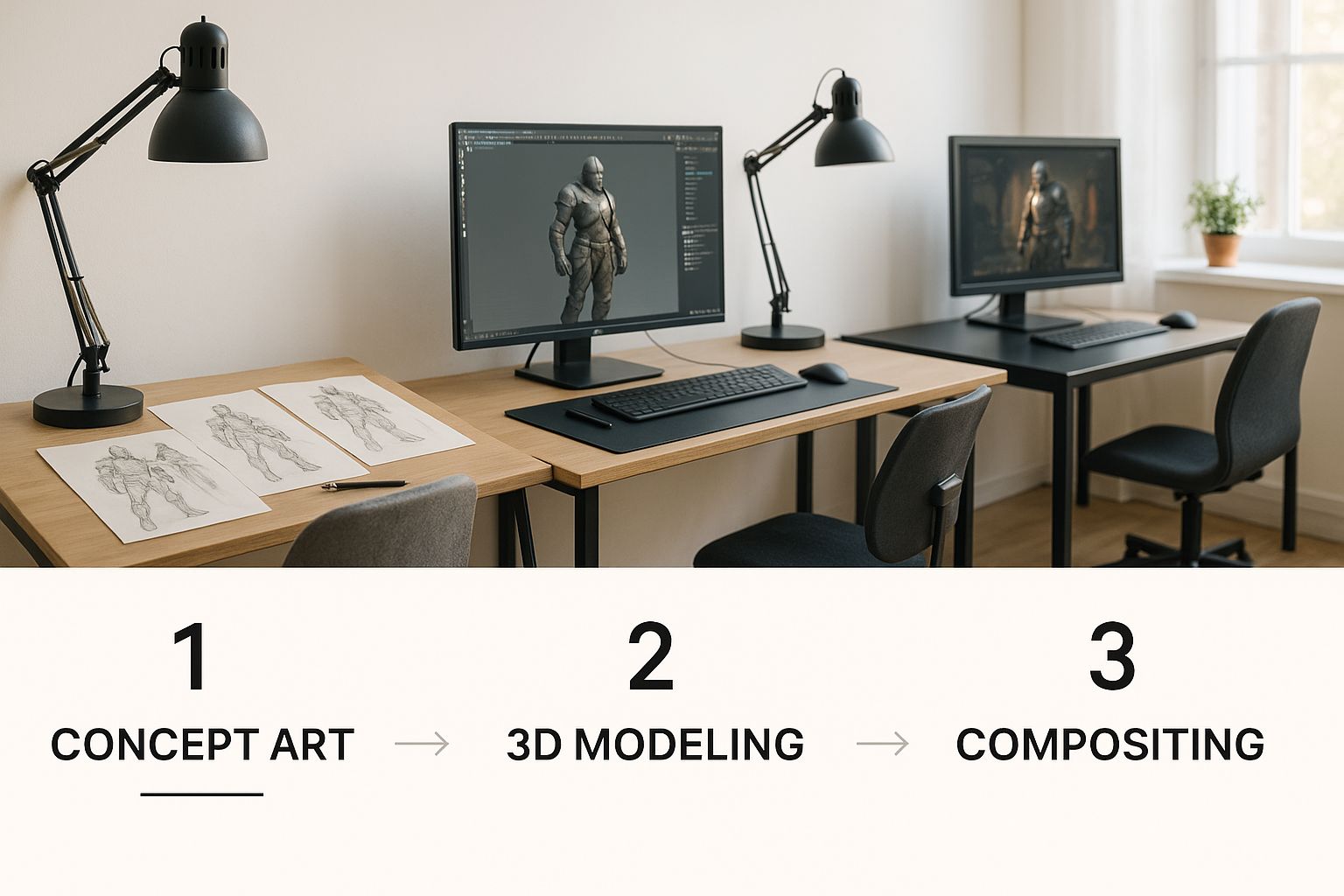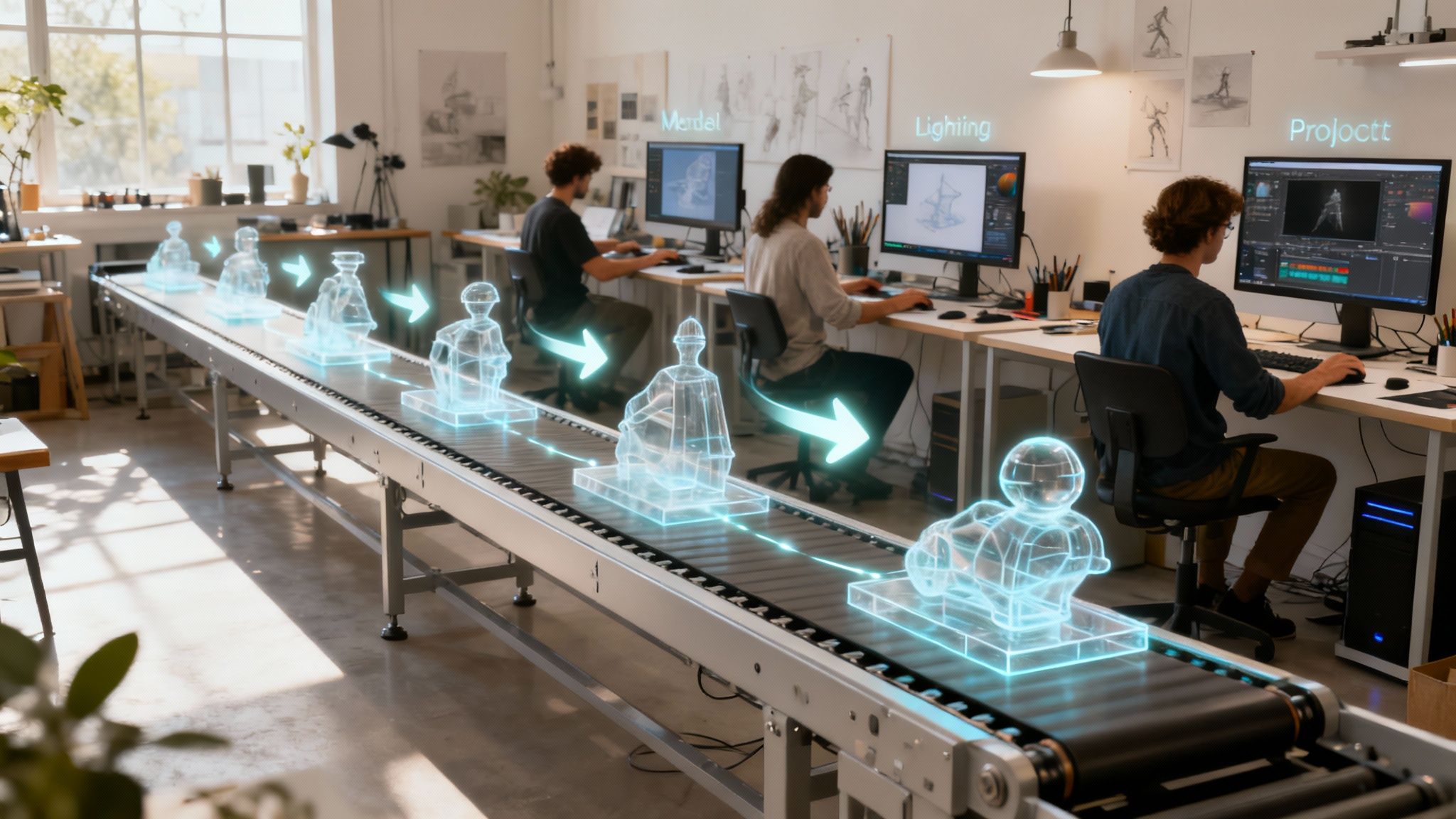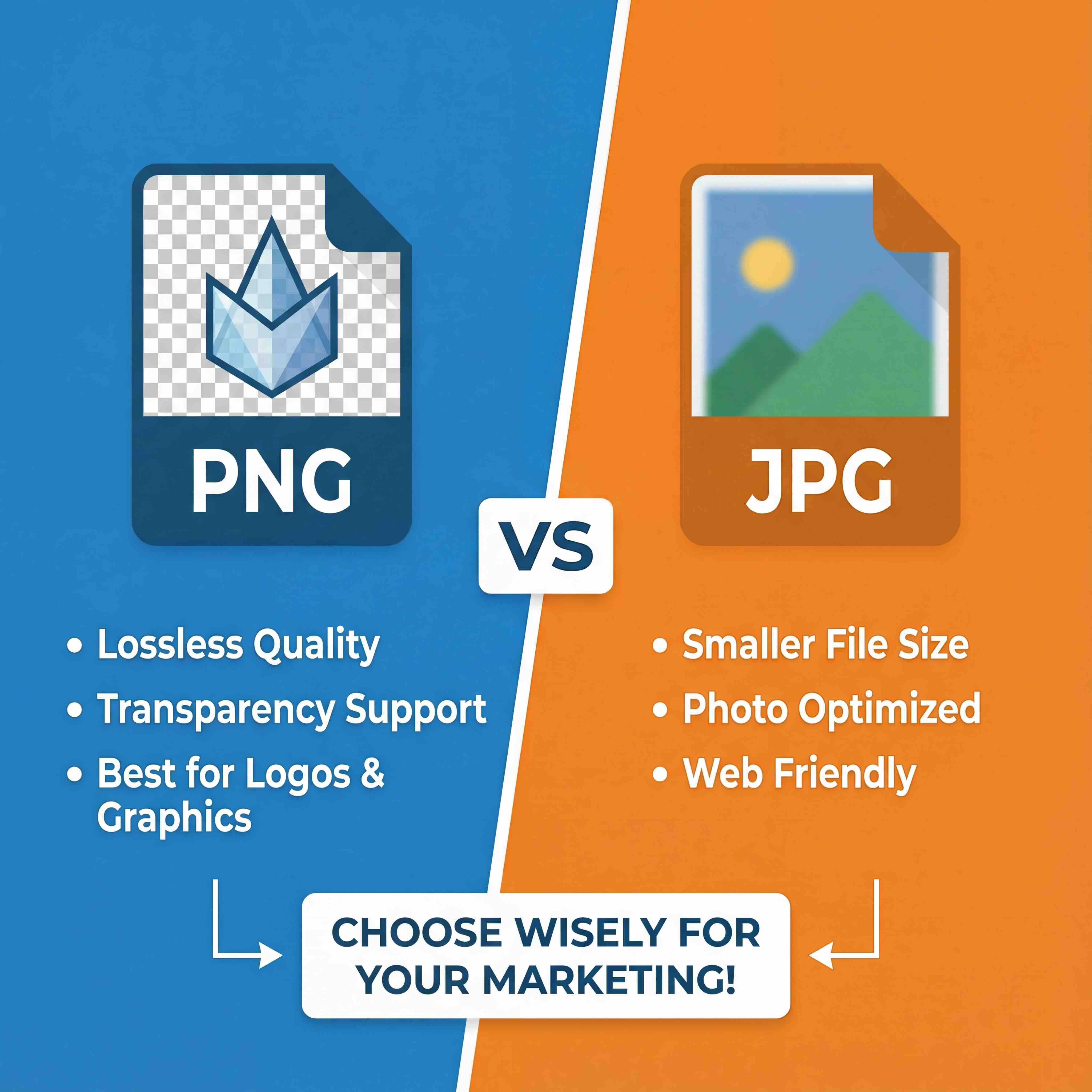In the world of visual creative work, complex projects can quickly become disorganized.
Pipeline management is the operational framework that brings order to that creative chaos. It’s a structured, secure path that guides a project from its initial concept to the final deliverable, ensuring every step is organized, tracked, and efficient. Think of it as an assembly line, but for high-value digital assets. For any creative studio focused on delivering complex work on time, on budget, and within compliance standards, this system is essential.
Unpacking Creative Pipeline Management

Picture a large-scale 3D animation project for an enterprise client. It begins as a rough concept, then must pass through the hands of concept artists, modelers, animators, and lighting experts before it’s finalized. Without a clear, secure system, that process could spiral into missed deadlines, inconsistent quality, and potential compliance issues. This is precisely where understanding what is pipeline management becomes a strategic advantage.
At its core, a creative pipeline creates a predictable and auditable journey for every digital asset. It defines the exact sequence of tasks, specifies which approved tools are used at each stage, and clarifies how assets move securely from one artist to the next. This structure isn't about limiting creativity; it's about removing operational risks and administrative headaches so artists can focus on what they do best: creating exceptional visual content.
The Foundation of an Organized Workflow
A well-architected pipeline is the operational backbone for any ambitious visual production. It manages complexity by setting clear rules of engagement and automating processes for how work is executed and reviewed. For any professional studio, this represents a shift from reactive problem-solving to executing with a proactive, strategic, and compliant plan.
This systematic approach is especially critical for maintaining consistency and security across large-scale projects. It ensures every asset—whether it's a character model for a game or a VFX shot for a film—meets the same technical, artistic, and security standards. By standardizing the workflow, teams can avoid versioning errors and communication breakdowns that often derail creative work and introduce risk.
A strong pipeline isn't just a set of rules; it's a common operational language for the whole team. Here are the core principles that make it work.
Core Principles of a Creative Pipeline
Ultimately, these principles work together to create a workflow that is reliable, secure, and ready to handle the demanding creative challenges of enterprise-level projects.
A pipeline isn't just a workflow; it's a shared language for your entire creative team. It ensures everyone understands their role, the status of each asset, and how their contribution fits into the larger project, fostering a secure and collaborative environment.
Preventing Bottlenecks and Delays
One of the most significant benefits of effective pipeline management is its ability to identify and resolve bottlenecks before they impact production schedules. When the entire workflow is mapped out visually, project managers can easily spot potential logjams, reallocate resources, and keep the project moving forward smoothly.
This foresight is a game-changer for operational efficiency. In fact, studies show that companies with optimized management practices grow 28% faster than their competitors. A clear pipeline provides the visibility needed to keep projects flowing, ensuring every team member has the correct assets and information right when they need it. This is how you protect your timelines, your budget, and your client relationships.
Navigating the Stages of a Creative Pipeline
Every visual masterpiece, whether for a blockbuster film or a global marketing campaign, follows a distinct journey. A pipeline organizes this journey into clear, sequential stages that guide a project from a raw concept to a polished, final asset.
Properly defining these stages is key to managing the entire process responsibly. It ensures tasks are completed in a logical order, preventing teams from building on unapproved concepts or deviating from the established creative and technical brief.

This visual shows how an asset flows from a simple sketch to 3D modeling and finally into post-production. It’s a clean, logical handoff at each step—exactly what a well-managed pipeline should deliver.
Stage 1: Pre-Production
This is the foundational phase where the project's vision is established, reviewed, and defined. Pre-production is centered on planning, ideation, and setting the creative direction before significant production resources are committed.
Rushing this stage can lead to scope creep and costly inconsistencies later on.
Key activities here usually include:
- Concept Art: Artists create initial sketches and detailed illustrations to establish the visual style, mood, and design of characters, environments, and key assets.
- Storyboarding: A sequence of drawings that visualizes the narrative, maps out camera angles, and plans the action.
- Asset Lists: A detailed inventory of every digital asset required for the project, from character models and props to textures and sound files.
The output from pre-production is a clear blueprint that guides the entire team. This level of planning is analogous to how industrial pipelines are meticulously engineered before any construction begins. The global pipeline network, which stretches over 3.5 million kilometers, relies on intense upfront management to function safely and reliably.
Stage 2: Production
With the blueprint approved, the production phase is where the creative vision begins to materialize. This is where artists and technical specialists execute the plan, turning concepts into tangible digital assets.
This stage is the core of asset creation.
This stage typically involves:
- 3D Modeling: Artists construct the geometric forms of characters, objects, and environments based on the approved concept art.
- Texturing & Shading: Surfaces are detailed with "painted" textures and materials are developed to give assets their realistic or stylized appearance.
- Rigging & Animation: Digital skeletons are built for characters, and animators bring them to life with movement.
- Lighting: Virtual lights are placed in a scene to create mood, depth, and visual focus, enhancing the narrative.
The specific goals here can vary significantly depending on the final output. For instance, the steps for building a game asset are very different from the process of making viral YouTube Shorts. A clear pipeline ensures the correct process is followed for the intended deliverable.
Stage 3: Post-Production
Finally, post-production is where all the individual components are assembled, refined, and polished into the final deliverable. It’s the last stop on the journey, where visual effects, sound, and color grading come together to create a cohesive, impactful final piece. A visual tool like a Kanban board is perfect for organizing these final, crucial tasks.
Post-production is the critical final step that harmonizes every preceding effort. It involves compositing, color correction, and final rendering—transforming a collection of assets into a seamless, compelling narrative ready for delivery.
Each of these stages requires careful oversight, secure asset handling, and crystal-clear communication. A smooth, auditable transition from one phase to the next is what separates a chaotic project from a successful, compliant one.
Why Your Creative Team Needs Pipeline Management
In any creative studio, a lack of process can lead to operational chaos. Without a system, teams often find themselves reacting to problems—missed deadlines, versioning nightmares, and budget overruns become the norm.
Adopting a structured workflow, or a pipeline, is no longer just an option for professional creative teams; it's a necessity for sustainable growth and client trust. It creates a single source of truth that aligns every artist, producer, and director. This clarity has a direct business impact; studies show companies with optimized management can grow 28% faster than their peers. For a creative team, that means more predictable project outcomes and a reputation for reliability and security.
Overcoming Common Creative Hurdles
Consider the daily challenges in an unstructured environment. An artist works from an outdated 3D model. Critical feedback gets lost in a long email thread. Tracking the true progress of a project is based on guesswork.
A managed pipeline replaces that uncertainty with clear, repeatable, and auditable steps.
This structure delivers tangible benefits:
- Smooth Handoffs: A modeler knows exactly when an asset is ready for texturing. An animator is notified the moment a rig is approved. There is no ambiguity.
- Airtight Asset Tracking: Every file, from the first concept sketch to the final render, is versioned and tracked in a central system. The risk of using an incorrect iteration is eliminated.
- Built-in Quality Control: Review and approval gates are integrated directly into the workflow. Every asset must meet project standards before it can advance to the next stage.
A well-managed pipeline is the difference between controlled, intentional creation and a constant state of reaction. It builds a secure foundation where artists are free to innovate, knowing the operational details are completely handled.
The Problem with Old-School Workflows
What happens when a studio operates without a modern pipeline? It's a familiar story of good intentions undermined by manual processes and a lack of controls. To see the contrast, let's compare the two approaches.
Manual Chaos vs Managed Workflow
The difference is stark. One path leads to inefficiency and risk, while the other paves the way for focused, high-quality, and secure creative production.
Fostering Security and Empowering Artists
Beyond operational efficiency, a modern pipeline is fundamental to creating a secure and auditable production environment. When working on enterprise-level projects, protecting sensitive intellectual property is not optional. A pipeline enforces strict permissions and tracks every action, creating a clear chain of custody for every digital asset.
You can dive deeper into how this works in our guide to creative team project management.
Ultimately, this framework empowers your most valuable resource: your artists.
When administrative tasks—like searching for files, checking versions, and providing status updates—are automated, your team can focus on their core creative responsibilities. They spend less time wrestling with logistics and more time creating stunning visuals. A strong pipeline doesn't stifle creativity; it enables it by removing friction and mitigating risk.
Building a Pipeline That Scales with Your Studio
Anyone can create a simple workflow for a single project. The real challenge is building a pipeline that can scale with your studio—one that can support larger teams, more complex projects, and increasing client expectations for security and compliance.
Think of it as the foundation of a building. A simple one works for a small structure, but it will fail if you try to build a skyscraper on it. Engineering your pipeline correctly isn't just about managing today's workload; it's about future-proofing your entire creative operation.
First, establish a universal language for your assets. Implementing clear, consistent naming conventions and folder structures is the bedrock of an organized, secure pipeline. When an animator can instantly find CH_Hero_Rig_v03 instead of digging through folders for Final_Character_Update_New, you've prevented errors and saved hours of wasted time.
Automating the Repetitive Work
With a solid organizational system in place, the next major gain comes from automation. Many tasks in a visual effects or animation workflow are repetitive and administrative—file conversions, rendering daily reviews, or moving assets between stages.
Automating these processes is like giving your team a digital assistant that handles the non-creative, logistical tasks. This not only accelerates production but also dramatically reduces the potential for human error. The right tools can transform a cumbersome, multi-step manual process into a secure, single-click action.
A scalable pipeline is built on a culture of clear documentation and proactive communication. The technology enables efficiency, but it’s the shared understanding and commitment to the process that makes it truly powerful and secure.
Ensuring Version Control and Security
As projects grow in complexity, tracking asset versions can become chaotic. This is where robust version control becomes a non-negotiable component of your pipeline. It serves as a safety net, ensuring no work is ever lost and that every artist is always working from the latest approved file, which prevents costly rework.
This structured approach is also critical for security. The global market for industrial pipeline maintenance is projected to grow from $25 billion in 2024 to over $26.6 billion in 2025, driven by the need for operational safety and integrity. Creative pipelines are no different—they are essential for protecting your most valuable intellectual property. You can read the full research about these market trends on The Business Research Company.
Fostering a Culture of Documentation
Finally, a truly scalable pipeline is about culture as much as it is about technology. Every tool, standard, and process must be documented in a central, accessible knowledge base. This is essential for onboarding new team members efficiently and maintaining consistency as your studio grows.
If your workflow knowledge resides only in the minds of a few senior employees, your operation is inherently fragile. That model cannot scale effectively or securely.
By creating a living repository of your studio’s best practices, you empower the entire team to work with confidence and autonomy. This is where dedicated creative project management tools become indispensable, serving as a single source of truth for both your assets and your processes.
How AI Is Upgrading Creative Pipeline Management

The future of creative production is becoming more intelligent. The core principles of what is pipeline management are being amplified by artificial intelligence, transforming static, linear workflows into dynamic systems that can anticipate needs and enhance security.
AI-powered tools are no longer limited to automating a few repetitive tasks. They are evolving into an essential co-pilot for production teams, managing complex logistics and security protocols that operate behind the scenes.
This evolution allows creative studios to operate with greater speed and precision. Instead of an artist wasting valuable time searching through server archives, AI-driven asset management can make an entire creative library instantly and contextually searchable.
Intelligent Automation in Action
Imagine an AI that automatically analyzes and tags every asset your team creates. A new 3D model of a futuristic vehicle could be instantly tagged with keywords like "sci-fi," "vehicle," "hovercraft," and "metallic" without any manual input.
This simple action saves countless administrative hours. More importantly, it eliminates the inconsistencies of manual tagging, ensuring every asset is discoverable and properly cataloged for future use.
But AI's role extends far beyond organization. It is also becoming a vital component of strategic planning and security.
AI essentially acts as a digital producer, anticipating needs before they even become problems. By looking at data from past projects, it can predict bottlenecks in the pipeline, forecast how much render farm capacity you'll need, and flag resource shortages way ahead of time. This allows managers to be proactive instead of constantly putting out fires.
This predictive capability is a game-changer for keeping complex visual projects on schedule and within budget.
Enhancing Security and Compliance
For creative work intended for enterprise clients, robust security and compliance are non-negotiable. AI introduces a new layer of automated oversight that helps build a more responsible and secure production environment.
It can automatically enforce access controls, ensuring only authorized individuals can view or modify sensitive intellectual property. This minimizes the risk of accidental data exposure.
- Automated Auditing: AI can create a secure, immutable log of every action taken on an asset, from its initial creation to final delivery. This provides a clear audit trail, which is crucial for meeting compliance requirements.
- Threat Detection: Advanced systems can monitor for anomalous activity, such as unusually large downloads, and flag potential security breaches in real time.
- Content Moderation: For brand-sensitive projects, AI can scan renders and assets to automatically verify they adhere to brand safety guidelines or other specific project constraints.
These features reduce human error and fortify the entire pipeline against both internal mistakes and external threats.
The Future of Creative Decision-Making
Ultimately, integrating AI into pipeline management frees up your team's most valuable asset: their creative energy.
By offloading the administrative and security busywork, it gives artists and directors more mental bandwidth to focus on what truly matters—the creative vision. To see how AI is reshaping other areas of the industry, it's worth exploring the latest AI applications in digital marketing.
The result is a workflow that's smarter, faster, and more secure, where technology genuinely supports creativity at every stage.
Got Questions About Pipeline Management? We Have Answers.
Implementing a formal creative pipeline often raises many questions. Understanding what pipeline management is is the first step, but applying it effectively to your visual creative team is another challenge. Here are clear answers to common inquiries from professional teams.
Getting these fundamentals right is the first step toward building a workflow that’s not just faster, but also more secure and reliable from day one.
What’s the Real Goal of a Creative Pipeline?
At its core, the main goal is to establish a predictable, repeatable, and efficient path for any digital asset, from initial concept to final, approved product. It’s about replacing ad-hoc, chaotic processes with a clear system that everyone on the team understands and follows.
This structure achieves several key business objectives:
- Ensures Consistency: It guarantees that every asset meets the same technical and quality standards, which is critical for brand integrity.
- Improves Collaboration: It defines clear, secure hand-offs, so artists know precisely when their task is complete and who is responsible for the next step.
- Enhances Predictability: It becomes far easier to estimate timelines and budgets with accuracy, building client trust.
In short, it’s about removing the operational risks and administrative burdens so artists can focus on creating high-quality visual content.
Is This Pipeline Stuff Only for Big Studios?
Not at all. While large visual effects and animation studios pioneered many of these practices, the principles are scalable and beneficial for creative teams of any size. A solo artist can use a personal pipeline to maintain organization, and a small team of five can use one to eliminate versioning errors and communication gaps.
The pipeline's complexity simply scales with your needs. A small team might have a simple three-stage process. A major studio might have a dozen highly specialized stages with multiple compliance checks. The core benefit—creating order, security, and predictability—is universal.
The real value of a pipeline isn’t tied to team size; it’s tied to project complexity. The second you have multiple artists working on assets that depend on each other, a structured pipeline becomes non-negotiable for keeping quality and security in check.
How Is This Different from Regular Project Management?
That's an excellent question. The two disciplines are closely related but serve different functions.
Think of it this way:
- Project Management is the "who, what, and when." It provides the high-level view, dealing with the overall project scope, deadlines, resources, and budget.
- Pipeline Management is the "how." It focuses on the specific technical and artistic workflow. It defines the precise steps, tools, file formats, and review protocols used to create and secure the asset.
Your pipeline is a critical component within your broader project management strategy. The project plan might state, "The 3D character model is due on Friday." The pipeline defines the exact, secure modeling, texturing, and rigging steps required to get it there correctly and on-spec.
Can a Bad Pipeline Actually Hurt Creativity?
Absolutely. If a pipeline is too rigid, outdated, or poorly designed, it can become a significant obstacle to creativity. A workflow that forces artists into awkward workarounds, relies on inefficient tools, or has overly bureaucratic approval gates can drain morale and stifle innovation.
A good pipeline should feel like a support system, not a straitjacket.
The key is to build a system that automates the tedious, non-creative parts—like file conversions, version tracking, and notifications—while providing artists the freedom and tools to experiment where it matters most. When designed correctly, a pipeline is a massive productivity multiplier that removes administrative friction, allowing artists to focus entirely on their craft in a secure, stable environment.
Ready to move beyond chaotic workflows and build a pipeline that fuels creativity? Virtuall provides an AI-powered Creative OS that unifies asset generation, management, and collaboration in a single, secure workspace. Discover how your team can move from concept to final asset faster than ever before.











